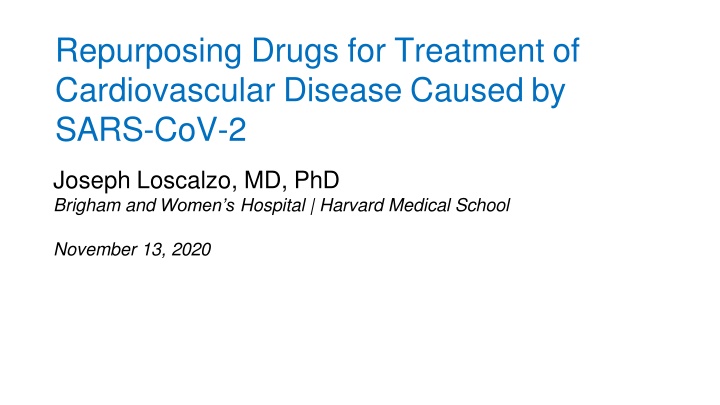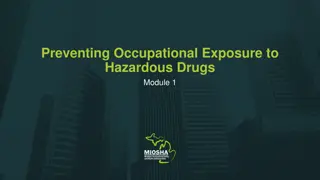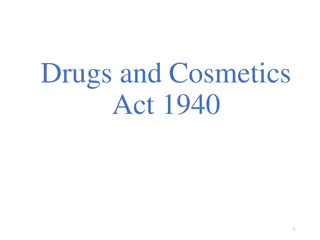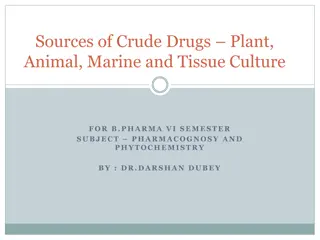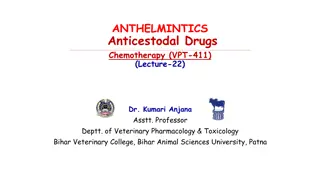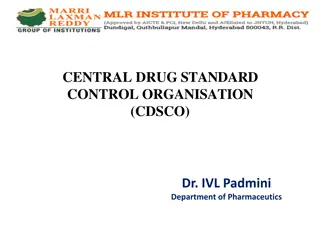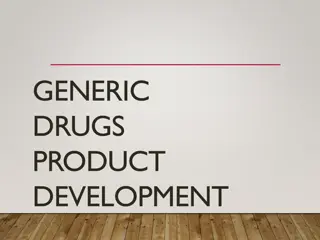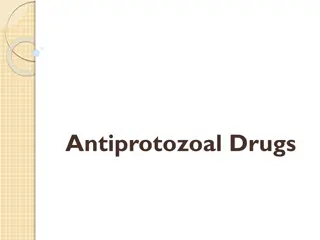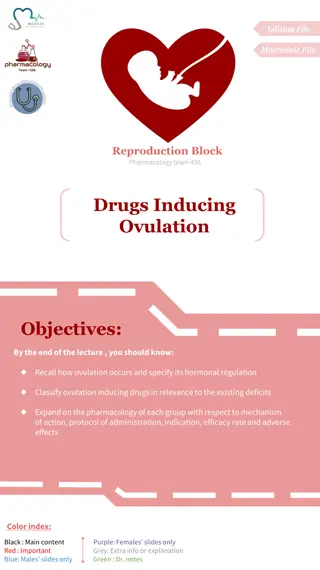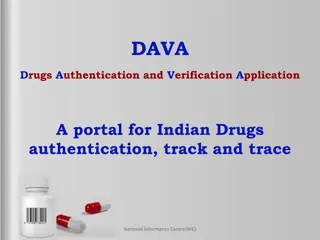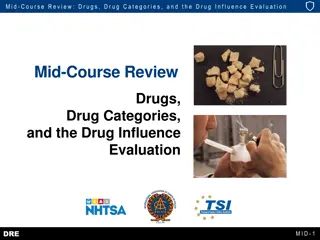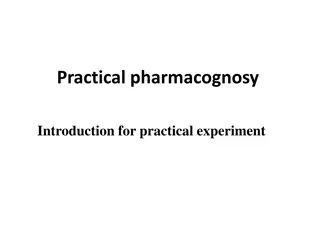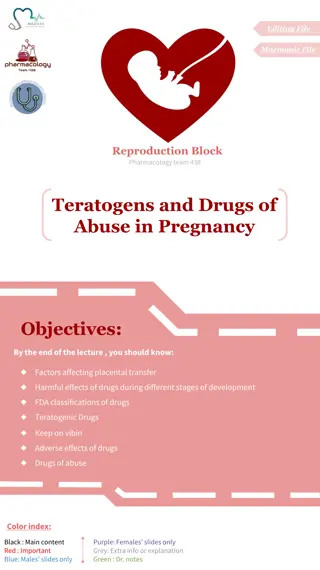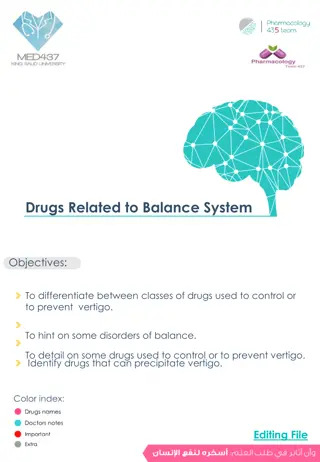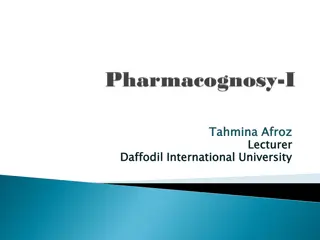Repurposing Drugs for Treatment of
Repurposing existing drugs for the treatment of cardiovascular disease resulting from SARS-CoV-2 infection is a promising approach explored by Joseph Loscalzo, MD, PhD, from Brigham and Women's Hospital at Harvard Medical School. The study delves into repurposing candidates targeting proteins in the pulmonary and cardiac Covidome, linking 332 human proteins to SARS-CoV-2. By identifying disease modules and leveraging interactome networks, this research aims to uncover potential drug targets with proximity to disease-associated proteins.
Download Presentation

Please find below an Image/Link to download the presentation.
The content on the website is provided AS IS for your information and personal use only. It may not be sold, licensed, or shared on other websites without obtaining consent from the author.If you encounter any issues during the download, it is possible that the publisher has removed the file from their server.
You are allowed to download the files provided on this website for personal or commercial use, subject to the condition that they are used lawfully. All files are the property of their respective owners.
The content on the website is provided AS IS for your information and personal use only. It may not be sold, licensed, or shared on other websites without obtaining consent from the author.
E N D
Presentation Transcript
Repurposing Drugs for Treatment of Cardiovascular Disease Caused by SARS-CoV-2 Joseph Loscalzo, MD, PhD Brigham and Women s Hospital | Harvard Medical School November 13, 2020
Disease Modules in the Interactome Curation of all experimentally validated protein-protein interactions in the human cell that form the human interactome 13,470 Nodes 141,296 Edges Peroxisomal Disorders Rheumatoid Arthritis Binary PPI (Y2H, IntAct, MINT) Regulatory (TRANSFAC) Metabolic (CORUM) Kinase and Signaling Networks Literature Curation (IntAct, MINT, BioGrid, HPRD) Multiple Sclerosis --Menche, et al., Science 2015;347:1257601
Disease Module Derivation: Cerebrovascular Disease CBVD Proto-module Identify disease phenotype of interest (CBVD). Ascertain disease network components ( seed proteins). Map seed proteins to interactome. Identify disease module(s) within interactome network. Seed Proteins Connector Proteins --Wang & Loscalzo, J Mol Biol 2018;430:2939-50 The interactome provides the missinglinks among disease-associated proteins in the disease module.
COVID-19 Disease Module: The Pulmonary Covidome 332 human proteins to which 26 SARS-CoV-2 proteins bind (Gordon et al., Nature, 2020), mapped to the interactome Repurposing candidates must target proteins within the covidome or very near it. https://arxiv.org/abs/2004.07229
COVID-19 Disease Module: The Cardiac Covidome 332 human proteins to which 26 SARS-CoV-2 proteins bind (Gordon et al., Nature, 2020), mapped to the interactome Repurposing candidates must target proteins within the covidome or very near it.
COVID-19 Disease Module: Overlap with Obesity Module One of four disease modules that overlap with the covidome Nominal statistical significance: p=0.06
Two Strategies for Drug Target Identification Network-based Drug Target ID Network-based Drug Repurposing: The Proximity Hypothesis Disease Module Drug Target
COVID-19 Disease Module and Interactions Human-Human Protein-Protein Interaction Drug Target-Human Protein-Protein Interaction Viral-Human Protein-Protein Interaction Human Interactome Viral Interactome Covidome Drug Target- Disease Module COVID-19 Disease Module https://arxiv.org/abs/2004.07229
General Approach to Drug Target Identification in the Covidome Network Proximity 3 pipelines Network Diffusion 5 pipelines Individual methods offer complementary information harnessed by the combined ranking algorithm for optimal predictive power. Network AI 4 pipelines https://arxiv.org/abs/2004.07229
Curated Drug Ranking & HTS --Drugs in clinical trials shown in green--greater intensity indicates greater number of trials. --Drugs with reported positive effects (e.g., ritonavir, ivermectin) appear in list. --We cannot tell whether a drug on this list will suppress the infection or worsen it; in vitro testing is essential. --This list does not provide information on other drug targets, which may lead to adverse effects (such as with hydroxychloroquine). --HTS for SARS-CoV-2 in vitro viricidal activity yielded ~50% success rate (far greater than the <1% hit rate of random screenings). https://arxiv.org/abs/2004.07229
Creating a Comprehensive Atlas of Human Protein- Drug (Small Molecule) Interactions Lawrence Livermore National Laboratory Sierra System (near exa-scale) Center for Accelerated Drug Discovery Human Proteins: 28,658 models for 14,119 proteins Experimental structures (>35%): 7,874 Experimental structures (>10%): 9,894 M Small Molecule Compounds: ~2M 1.5M 5,557 26,490 244,801 135,335 ChEMBL: Approved drugs: Foodome: NCI60: ZINC Biogenic: N Specific interactions between drugs and protein targets will be used to map the drug targets to the PPI, which should yield comprehensive information on the breadth of disease treatments and adverse effects.
Ongoing Work --Test top hits in human cell assays with SARS-CoV-2: HuH-7, Calu-3, pericytes, ECs, CMs. --Study repurposed drug combinations. --LLNL--CADD high-performance computing analysis of potential repurposed drug targets in or near the covidome --Proposed human trials
Acknowledgements Feixiong Cheng Deisy Morselli Gysi Italo Do Valle Vlad Elgart Dina Ghiassian Diane Handy Laurel Lee Jane Leopold Jun-Seop Song Ruisheng Wang Jerry Zhu Laszlo Barabasi Rob Davey Rishi Desai Felice Lightstone Joerg Menche Sebastian Schneeweiss Marinka Zitnik
